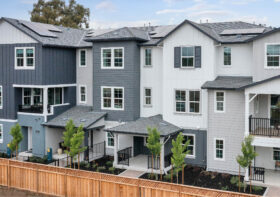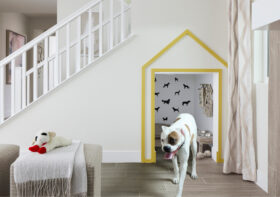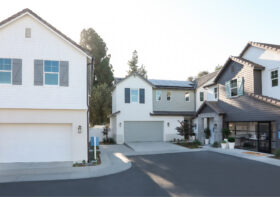Architectural Product Types: Cluster Homes

One of the current challenges in housing development is maximizing limited land space while retaining a single-family detached home. One of the solutions is “Court Living.” This architectural product type is a cluster of several homes that share a common driveway or alley. The cluster module can maintain a conventional street character by having homes with front doors facing the street with a second or third row of homes accessed by a shared alley. Like a private street or cul-de-sac, residents can utilize the common court space. Traditionally marketed as starter homes, court living is becoming increasingly popular due to today’s skyrocketing home prices and limited availability of land.

Auto Court / Motor Court Cluster: Four or more units are arranged with front doors and garages facing a common stub street or driveway.
Design Criteria:
• Provide front doors to the auto court for inside units and to the street for outside units.
• Use enhanced elevations for homes facing the public street.
• Provide porches or balconies to enhance architectural styles.
• Consider additional building articulation through recessed garage doors, recessing or cantilevering second stories, and varying roof pitches and directions.

Pros:
• Each unit has its own private rear yard.
• Outside units face the street and maintain a conventional street character.
Cons:
• Inside units have front doors facing a common driveway.
• Guests must walk past front units and into the court to reach inside units.
• Front yards for inside units are limited.

Green Court Cluster: Four or more units are arranged with front doors facing a common green paseo with a rear alley for garage access.
Design Criteria:
• Provide front door access to the green court.
• Use enhanced elevations for homes facing the public street.
• Provide front door entries along the public street.
• Place garage access at rear allies.
• Provide opportunities for landscaping along the green court and rear allies to soften the architecture.
• Provide landscape and monument features at the green court entries.
• Provide porches and/or covered entries facing the green court.
• Consider additional building articulation through recessed garage doors, recessing or cantilevering second stories, varying roof pitches and directions, and varying the setbacks of the homes along the green court.

Pros:
• Garages are tucked behind homes on a rear alley allowing for a large front porch or front yard.
• Guests and residents can walk inside a landscaped path to reach their destination.
Cons:
• Each unit will have only a private side yard but no backyard and depending on the layout of the cluster, there may be reciprocal side yards.
• Units have only a small driveway apron instead of a full driveway.






Leave a Reply